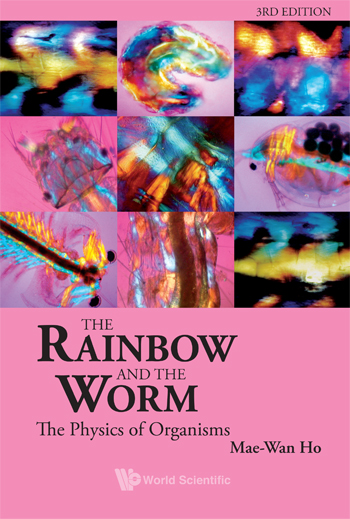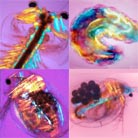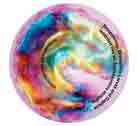Dr. Mae-Wan Ho
Director, Institute of Science in Society
"Probably the most important book for the paradigm change"
Order Online: The Rainbow and the Worm: The Physics of Organisms
An accompanying CD and DVD featuring stunning video images of live organisms are also available at the I-SIS online store
Rainbow and the Worm CD-ROM | Quantum Jazz DVD


A fusion of contemporary jazz music and digital video recording of live organisms. Now available for download available here | more info

The accompanying download contains high resolution movie files of the organisms that inspired the book - taken from a polarizing light microscope: Drosophila, Daphnia and Artemia available here
Reviews and Quotes
"A very original survey of how biology may be linked to physics through the concepts of coherence and of coupled processes. Although deeply serious, the writing has a pleasant touch of gaiety, due to the author's sense of excitement in the central problem: What constitutes 'being alive'?"
K.G. Denbigh, Emeritus Professor of Physical Chemistry, Queen Elizabeth College, and distinguished author of many books on non-equilibrium thermodynamics
"The layman may not understand half of this book, but he will understand more than he expects to or may feel he has any right to. The author, whether discussing 'quantum en-entanglement' or 'energy-flow', 'dynamic order' or life as 'collective response to weak signals', has the gift of making the reader dream."
P.N. Furbank, Emeritus Professor of English, Open University and author of many scholarly books and biographies
"..an excellent introduction to the more physically motivated approaches to understanding biological complexity. And there's not a gel in sight."
Douglas B. Kell, Trends in Biochemical Sciences
"It is high time a good book was available to not only teach biologists some physics, particularly bioenergetics, but make them sit up and think a bit more deeply about it. This little volume is more readable than other drier and much weightier books on the subject."
Cell Biology International
"The book is the coming together of many highly exciting ideas of contemporary physics…one that draws on a range of experiment and theory, and illuminates Ho's definition of life as a 'process of being an organizing whole'."
American Scientist
"…'what is life?' Mae-Wan Ho presents an interconnected system of proposals, experimental results and conjectures which go a large way towards proving an entirely new answer to this question. It is based on research which is mainstream in its theoretical physical foundations, though innovatory in some of its techniques. This makes the book highly important, and if she is right it would be revolutionary."
Network
"…a fascinating excursion towards and beyond the limits of physical science fifty year on from Schrödinger's classic."
David Llyod, Binary-Computing in Microbiology
"…a truly stimulating and beautifully written book, full of new perspectives and researchable ideas."
Ervin Laszlo, author of many books including The Whispering Pond
"..a remarkably eclectic work, joyously written and a joy to read. I certainly learned a lot from it."
Geoffrey Sewell, Professor of Physics, and author of Quantum Physics of Collective Phenomena
"…the author clearly understands the "whys" of the world at a depth and breadth which no one else approaches ….clinical medicine requires this kind of insight."
Walter Bortz, MD, author of Dare to be 100
"The book is recommended to all scientists who are interested in understanding life….Fifty years after Schrödinger's "What is Life?", this book is a worthy instalment, since it intensifies the original matter of Schrödinger."
Fritz-Albert Popp, International Institute of Biophysics, Germany
About the Author
After obtaining her PhD in Biochemistry, Hong Kong University, Mae-Wan Ho embarked on a distinguished research career that included a postdoctoral fellowship in Neurosciences, University of California at San Diego, Fellowship of the National Genetics Foundation, USA. Senior Research Fellow in Biochemistry, University of London, Lecturer in Genetics then Reader in Biology, Open University. Her research evolved through biochemistry to molecular genetics, non-Darwinian evolution, and since 1988, the physics of living organization, defining a new field with the present book, widely acclaimed by serious scientists across the disciplines and by non-scientists alike.
A serious, in-depth enquiry into Schrödinger's question, "What is Life?" and at the same time, a celebration of life itself
A voyage of discovery through many areas of contemporary physics from non-equilibrium thermodynamics to quantum optics in order to understand the problem of life
A rare and exquisite view of the organism, giving novel insights, not only into the physics, but also "the poetry and meaning of being alive"
Contents:
Readership: General
Got something to say about this page? Comment